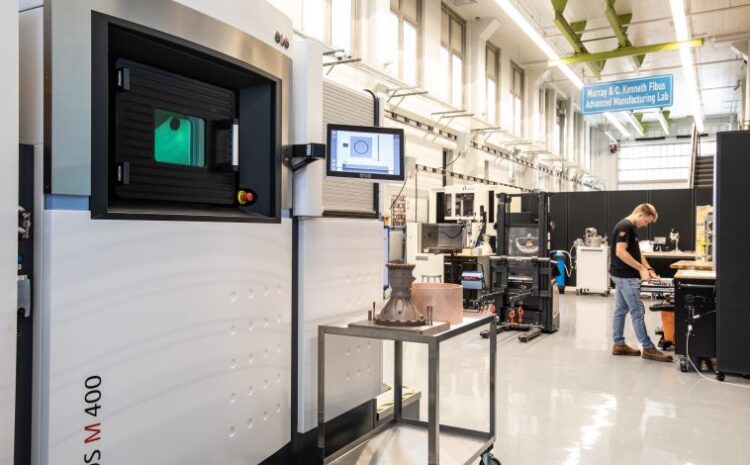Ursa Major’s Youngstown Lab Reduces Production Time to One Month
By Terry Troy
Earlier this summer, Ursa Major, America’s only privately-funded company that focuses solely on rocket propulsion, announced the delivery of its first copper-based 3D-printed rocket engine chamber developed at its additive manufacturing lab in Youngstown. Last week, the company also announced that it had entered into a contract under the U.S. Air Force Tactical Funding Increase (TACFI) program.
The development of 3D components reduces the production and delivery cycle from six months in traditional manufacturing processes to one month with the 3D process. The advanced alloy copper components are being tested for space launch and hypersonic applications.
“Speed is of the essence when it comes to producing rocket engines right now because lack of propulsion is causing a significant bottleneck in U.S. access to space and hypersonics testing,” said Joe Laurienti, founder and CEO of Ursa Major. “The Ursa Major facility in Youngstown is playing a pivotal role in accelerating our customers’ time to market in both commercial and government sectors.”
The Lab’s charter is to develop and test additive manufacturing (3D printing) processes and materials for Ursa Major’s rocket engines, used for both space launch and hypersonic applications.
The Ursa Major Advanced Manufacturing Lab began in October of 2021, with $3 million in federal financial support from the Department of Defense-backed manufacturing innovation institute America Makes.

“Ursa Major’s goal to help establish the U.S. as a global supplier of rocket propulsion is in line with our efforts to foster domestic innovation and manufacturing across industries in Ohio,” said Rep. Tim Ryan., a proponent of America Makes. “I’m pleased that Youngstown is home to this state-of-the-art facility that will ultimately help the U.S. regain its leadership in space and hypersonic technologies.”
The Youngstown-based facility is equipped with an EOS large-format laser powder bed fusion 3D printer designed to make on-demand components for Ursa Major rocket engines. It is located in the Youngstown Business Incubator, an internationally recognized program focused on the development of software and additive manufacturing companies in the region.

“This type of advanced additive manufacturing is a great example of the kind of American innovation that America Makes seeks to support,” said John Wilczynski, Executive Director of America Makes. “Successful projects like this are part of a resurgence in American manufacturing that helps strengthen our domestic supply chain.”
The existing supply chain for high temperature metal alloy components is limited, and it can take months to turn around a needed revision. The Advanced Manufacturing Lab accelerates the engine development process, allowing Ursa Major to rapidly iterate on design adjustments in-house to improve engine performance and reliability.
The Advanced Manufacturing Lab was critical to rapidly redesigning Ursa Major’s “Ripley” from a 35,000 to 50,000-pound thrust engine in order to meet market demand. The technical
lessons learned from Ripley and the methods and materials produced are now contributing to the development and testing of their two other rocket engine programs – the “Hadley,” a 5,000-pound thrust, oxygen-rich staged combustion engine used in small launch and hypersonics, and a new 200,000-pound thrust “Arroway” designed for medium and heavy launch.
Last week, Ursa Major announced a contract under the U.S. TACFI program. Under the agreement, Ursa Major will provide a flight-qualified 5,000-pound thrust, oxygen-rich staged combustion “Hadley” rocket engine, suited for both the booster and upper-stage phases of launch for satellites into low-earth orbit.
While more challenging to engineer than other systems, oxygen-rich staged combustion (ORSC) is more efficient for better engine performance and is the architecture preferred by the world’s advanced space programs. This effort continues to build upon past investments into ORSC technology by the Air Force Research Laboratory (AFRL) to provide ORSC systems to the nation.
“We are proud of the Air Force’s continued support and recognition of Ursa Major’s leadership in developing reliable, high-performing, American-made rocket propulsion,” said Laurienti. “Choosing Ursa Major and the Hadley engine means more U.S. satellites in space, which is more important than ever for our national security and global technical leadership.”
Hadley was developed by Ursa Major’s team of world-class propulsion experts, who have more than 1,000 combined years of collective engine development experience on numerous successful launches and engine programs. Like all Ursa Major engines, Hadley delivers high performance, flexibility, and reliability at a significantly lower cost by using advanced manufacturing (3D printing) and a technology-first, market-driven design approach.
Hadley features active throttle, active thrust vector control, and a configurable fuel mixture ratio. It is qualified for operation in flight at various power levels and capable of continuously throttling from minimum to nominal flight power levels. Ursa Major has already delivered numerous Hadley engines to customers from its uniquely integrated 90-acre Colorado facility, which houses its engineering, manufacturing, and testing functions on a single property.
Ursa Major’s rocket engines are more than 80 percent 3D-printed by mass and primarily built and tested in its Berthoud, Colorado headquarters.
Ursa Major’s flexible rocket engines can be used for a range of missions, from air launch to hypersonic flight to on-orbit missions with many restarts. The company’s customers get to launch many years faster and without the development cost of building engines in-house. Ursa Major has built and tested more than 50 staged-combustion rocket engines to date and plans to deliver 30 customers by year’s end. To date, Ursa Major engines have accumulated more than 36,000 seconds of run-time, far more than a typical engine is tested prior to first flight.


